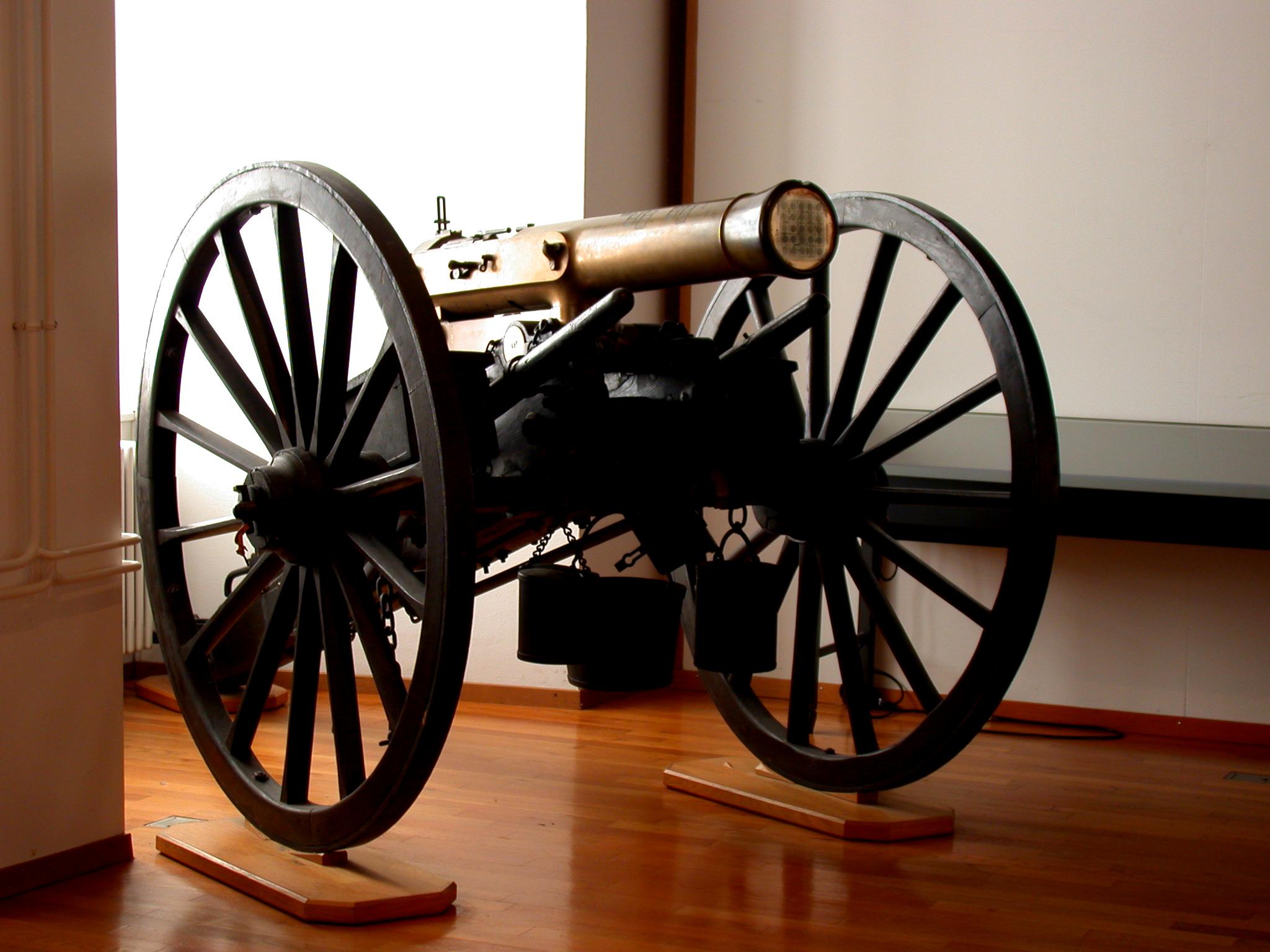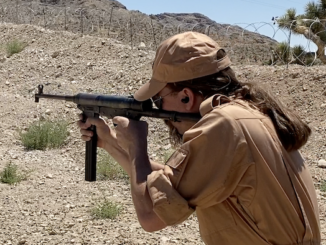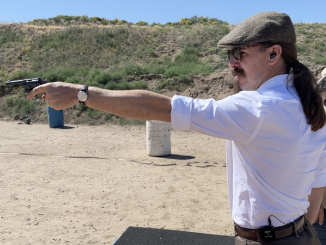The MAC PA 1950 (Pistolet Automatique Modele 1950) was the result of a 1946 French effort to standardize on a single military pistol. By the end of WWII, the French military had accumulated a mess of different pistols of French, Spanish, American, and German origin; officially using the Luger, P38, Mauser HSc, 1911 (and A1), 1935A, 1935S, Star, Ruby, and Model 1892 revolver.
Trials were held in 1950, although the outcome was predetermined – this pistol, designed by St Etienne and largely derived from the Model 1935S, was to be the next French military sidearm. A design from the SACM company was also tested, as was a commercially purchased SIG SP47/8, but this was for comparison sake only. In fact, the SIG was the best performer in the testing, with the St Etienne design suffering from cracked parts and durability problems. It would be improved, however, and deemed suitable for adoption by early 1951.
Production began in 1953 at the Chatellerault arsenal (hence the “MAC” name used in the US). All of 221,900 were made by Chatellerault until it was shut down in 1963, when production transferred to St Etienne, where another 120,000 would be made by 1978.
Mechanically, the gun is largely taken form the Browning 1911, with a few improvements. The recoil spring is of a captive design, and the fire control group is all built into a single easily replaced unit (similar to the Tokarev and the 1935S). It is single action only, with hammer-block and magazine safeties and a 9-round magazine of standard 9x19mm ammunition. It is still in French service, having proven to be a reliable and dependable weapon, if outdated by today’s standards.




“officially using the Luger, P38, Mauser HSc, 1911 (and A1), 1935A, 1935S, Star, Ruby, and Model 1892 revolver”
-Which Star?
-If list complete: why Mauser HSc, but not other pocket automatic pistols of German origin (like Sauer 38H or Walther PP)?
“standard 9x19mm ammunition”
I assume that this cartridge was manufactured in France. Does anyone known its ballistic data (bullet weight @ muzzle velocity @ barrel length)? Does France used special “hot” variant of that cartridge for sub-machine gun (MAT-49) or not?
The French adopted the Mauser HSc because Oberndorf, and therefor the Mauser factory was situated in the french occupied zone of Germany, and the simply re-started the production or better: used up the supply of already finished parts as part of reparations. Sauer and Walther where situated in Thuringia, which was Soviet occupied.
France adopted some, and not all, German pistols after WWII because the army and police adopted guns produced by French companies. These companies did not produce all the models of German origin. Also not that some were actually produced by French companies (like the Walther PP and PPK) but were considered to small for military use. These guns sometimes made their way to police hands. Walther PP of the French police do exist.
France adopted special 9 mm loads for pistols and SMG. I don’t have balistic datas for the SMG cartridge right now but the standard pistol catridge is this one :
“Balle O” (tombac round nose jacket with lead core)
125 grains bullet @ 1265 fps @ 4.37 in (8.1 grams at 385 m/s in a 111 mm barrel)
Energy is exactly 600 jouls.
In the MAT-49, energy would obviously be increased with this cartridge and the SMG load dedicated to the MAT-49 was even hotter.
This special SMG load was not adopted at the same time as the pistol cartridge, which was initially used for pistols and SMG.
Current French army 9 mm loads produce about 700 to 720 jouls of energy when fired from a pistol (Beretta 92 barrel) and are classified as +P or +P+ loads, depending of the cartridge.
Please excuse the mistakes, I didn’t checked my comment before sending.
Thibaud, according to STANAG 4090, the test barrel is 7.85″, the muzzle energy must be between 400 and 600 ft·lbf, and bullet weight between 108 and 128 gr. Is France using a load hotter than NATO specs?
720 Joules is only about 530 ft·lbf, which would probably mean that even from a 7.85″ barrel the muzzle energy of the French loading is less than 600 ft·lbf. The hottest NATO specs loads would be +P in SAAMI specs in any case, if I’m not mistaken. They certainly exceed the CIP maximum pressure limits for 9x19mm.
French loads are indeed hotter than average and hotter than NATO standard. France never was a good follower and always tried to do things its own way : own cartridges, own loads, own way to measure.
French army, as with many other nations in the XXth century, made its own loadings for their guns (remember the CZ52 roller delayed pistol in 7,62 Tokarev that used overpowered rounds initially designed for SMGs) and French sport shooters are very fond of straight trajectory, high velocity loads.
In this video https://www.youtube.com/watch?v=ElvzQoME_sI , you can see an average of 513 m/s with 90 grains 9 mm speer gold dot from a 6 inches barrel, which gives an energy of 767 jouls (565 fr.lbf).
It is a 6 inches barrel and it is not a military load, admitedly, and the shooter notes that this load (that he used for years) is so hot that you must compress the powder inside the case to be able to sit the projectile properly, but it shows were one can bring the 9 mm parabellum in terms of energy.
This kind of loads indeed greatly exceed the CIP max pressure. Note that USA did this too, with M9 loaded with overpowered cartridges reserved to SMG use, which was the start of the greatly exagerated broken slides issues.
The link to the shooting video doesn’t appear to be present here.
The unitized fire control group is REALLY excellent.
Following is not linked to MAC 1950, so ignore it if you wish:
TO: Anyone knowing français:
Can you translate adverts from here (3rd and 4th image from top):
http://littlegun.be/arme%20belge/artisans%20identifies%20i%20j%20k/a%20jacquemart%20gb.htm
Has anybody idea why “LE MONOBLOC” PISTOLET AUTOMATIQUE BREVETÉ was designed in such layout? Was it done purely to dodge some patents or it gives some advantages of then available automatic pistols? Why it is MONOBLOC but examined example shows MONOBLOG?
3rd ad:
Mechanical manufacture (as opposed to artisanal, I suppose) of hunting weapons of all types.
Joseph Jacquemart, Herstal-lez-Liège, Quai du Canal 28 (the adress)
Offices and factory: Rue du Poncay (Poncay Street), telegraph adress Jos. Jacquemart, Herstal.
Specialized in in shotguns, both with external hammers and hammerless.
Now for the 4th.
Mechanical manufacture (made in a shop with machine-tools as opposed to hand-made, I suppose) of hunting weapons of all types.
Joseph Jacquemart, Herstal-lez-Liège, Quai du Canal 28 (the adress)
“Le Monobloc”
The simplest automatic pistol of all models. Cal 6.35, 6 shots.
The frame, barrel and slide are from a single block of steel. This system gives the pistol absolute ruggedness, while giving it a very elegant aspect.
Holding the pistol in the right hand, the safety button falls directly under the thumb. Simply pressing it puts the pistol in either safe or fire condition.
Provided with a reasonable manufacturing method minimizing expensive machining process, like die casting, MlM or non ferrous alloy injection, monoblock construction is a cost saving application for complex formed units like pistol frames. However, rather negative side for the same, the lack of needed mass of the slide or breechbolt obtainable through this construction for bigger calibres. Another example manufactured decades later, Whitney Wolverine is also in a tiny, .22″ caliber.
Ian, dont take my word for it, but i read somewhere that the brown finish is actually bluing, but gets brown due to composition of the steel.
I brought this question up some years back into discussion in relation to Russian made firearms. They are conspicuous (namely machinegun parts) with reddish ‘tinge’.
My own opinion is that the discoloration may be result of chemical reaction of iron with salts used during heat (case hardening) treatment. Sometimes result is brownish as we see here, sometimes it goes into red or even blue-gray. Gun parts run thru “bluing” process typically end up black; as happen to one of my pistols which I has refinished.
IMHO the coloring is due to the thickness of the oxide layer. Thin Film Technologies would be a searchable term for a real explanation. Like a drop of oil on a mud puddle, the colors are an indication of how thick the layer is. When you move your head around, the apparent thickness of the layer changes because the reflection angle changes and the color seems shimmery. You can see this in the video when it glares out, or appears darker at low angles. The color on a lens is an indication of the lens coating thickness, not some blue or orange stuff.
I think you’re right about the heat treating being the cause.
Lahti L-35 pistol bolts with similar brownish tint, second from the right (Vammaskoski replacement):
http://www.jaegerplatoon.net/L35_slides.jpg
(Slide is an error in translation, since the L-35 does not really have a slide.)
Cool picture, I always like the comparisons of the same thing through time. A few observations about the picture, while second from right is reddish in the large flat area, it is almost the blackest in the almost squarish flat part. It is also the glariest around the edges. I don’t know what to make of that, it is too bad that the picture was taken through glass, maybe even with flash.
This is well designed gun and evidently following of Model 35. It may be that it part of M35 legacy also carries over some FN GP35 input, rather than 1911 US. It is logical that French adopted this gun as general issue.
One side question I’d have: was Legion also equipped with this sidearm? I’d expect not because of mentioned variety of older vintage. Also, as I recall, Manuhrin was making version of P38.
Manurhin (H after the R, like “MANUfacture du RHIN” Manurhin. The “Rhin” is the Rhine river, in French) did indeed produce the Walther P38 as the Manurhin P1 and P4.
The Legion indeed used the MAC50 pistol. Every branch of the French Army did use this pistol.
It seems the French did not take from the 1935S its newest and most cost-saving feature, the ejection-port to enlarged chamber lump lock; instead reverting back to the 1935A’s (and Colt-Browning original) multiple-lug and groove practice. This must have cost a bit in machining time but saved them on new machinery. The 1935S wasn’t the first ejection-port lug pistol (honors to Webley), but seems to be the first allied to a Browning tilting barrel. Incidentally, the 1950 adopts the FN P35 (and 1922 Astra) cam as a cost- (and wear-?) saving measure, while the 1935A and S retained the swinging link. So we had to wait for the SIG220 for the combination of simplifying features: barrel locked to the ejection port, and cam instead of swinging link. Odd is the mesh between engineering and military cost-accounting.
There it seems Frenchs accepted simple ejection port contacted barrel lock shoulder as an inferior, degraded application as compared to expensive multi lug construction.
The 7.65mm Long was also quite a bit weaker cartridge than 9mm Parabellum, so less need for a really robust locking system. It would have been quite feasible to use simple blowback with the 7.65mm Long, which had a muzzle energy similar to the 9mm Browning Long. So similar in fact, that Ian kept calling the cartridge “7.65 Browning Long” by mistake on the video.
On a related note, the 9mm Browning Long was also considered by the French Army after WW1 with the Le Francais type ARMEE pistol, but ultimately rejected.
I suppose that a Browning-action pistol chambered for 8×27 French Ordnance (or .38 Special) would have been a more ridiculous idea than adopting the Model 1935 since 7.65 Long was designed to be fed from magazines… Or am I wrong?
8mm French Ordnance was a much weaker cartridge than 7.65mm Long and like you wrote, it was also a rimmed revolver cartridge and unnecessarily long and low pressure for smokeless powder, so not much idea in adapting it. .38 Special, while more powerful than 8mm French Ordnance, would have also been a very poor choice for an automatic pistol. It would have made sense only if the French had wanted to emulate the British and adopt one more revolver as a service pistol.
As a side note, the French in the early 1970s did adapt one more revolver, the excellent Manurhin MR-73 in .357 Magnum, but that was for law enforcement use, although it was also used by the Gendarmerie, which is kind of a military organization; I don’t know if “paramilitary” is exactly the right word for it.
Wasn’t the MR-73 a Ruger Security Six (1st generation but robust Ruger DA) built under licence like the French-made selective fire Mini-14s Ian wrote about a couple of years ago? I’ve seen photos (years ago) of a Manurhin revolver that appeared identical to the Ruger .357s of the era.
No, MR-73 is own design (as much as DA revolver from early 1970s can be), later MR-88 was Ruger based.
Euroweasel, the Gendarmerie is not paramilitary, it is military. We call them “soldats” (“soldiers”) and they are “militaires” (“military men”). They are in fact part of the Armée de Terre (Army).
Jim in Houston, the MR73 is a proprietary design that doesn’t borrow from the Ruger Security-Six. The Mousqueton AMD (French Mini 14) is not a selective fire rifle, it is only semi-auto.
“use simple blowback with the 7.65mm Long”
Zhuk in his book has drawings of MAS, 1925, Model № 1 and MAS, 1932, type A № 4 and says they used blow-back principle and has cartridge counters. For both caliber 7,65 is given, which probably should be understand as .32 Auto (Zhuk use 7,65 Д to denote 7,65 Longue), on the other hand i found photo of:
http://laurentbelkacem.tumblr.com/image/107559432506
which seems to be variant of first (as it has also “1925”, but also “№2”) with inscription on it as follows:
M.A.S_7.65L_1925
№2
that “L” might stands for Longue, this example also has cartridge but with numbers: 0 4 8 when both example in Zhuk book have 0 5 10.
Additionally if you compare photo which i linked with 49-10 from here:
http://www.earmi.it/armi/atlas/271.htm
it seems that No2 has heavier slide (look at grooves for manual cycling), which seems to be logic if one fires .32 Auto and second 7,65 Longue, however I might be wrong with interpretation of drawing/photo.
–
These pistols (49-10 and 49-11 from link) seems to be designed with military use in mind judging from its size.
It is quite interesting, because it seems that they decided to sacrifice ballistic for bigger capacity of 10. This might mean that they consider .32 automatic pistols used during First World War to be success and “capacity over ballistic” path to be future of automatic pistol (during WW1 France used for example STAR Model 1914 (capacity: 9 or 7) and Gabilando Ruby (capacity: 9) which might explain capacity of 10 of No1).
“9mm Browning Long was also considered by the French Army after WW1 with the Le Francais type ARMEE pistol, but ultimately rejected”
Now I wonder whatever “use 9mm Browning Long” idea comes from French Army or from Manufrance? Caliber aside this automatic pistol was totally unsuitable for military service, as it loading procedure called for inserting magazine and round directly to chamber and unlike in most automatic pistol of that era, cartridge which fail to ignite (dud) mean big problem – it was impossible just to pull slide, but it has to be removed manually.
In all it is good example that requirement for pocket automatic pistol and military automatic pistol were vastly different at that moment and up-scaling successful design did NOT guarantee success.